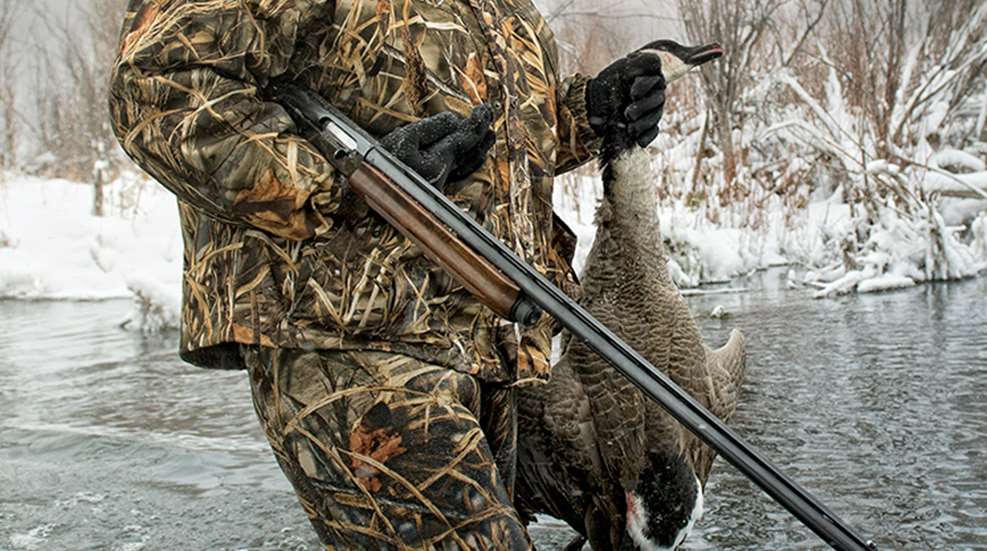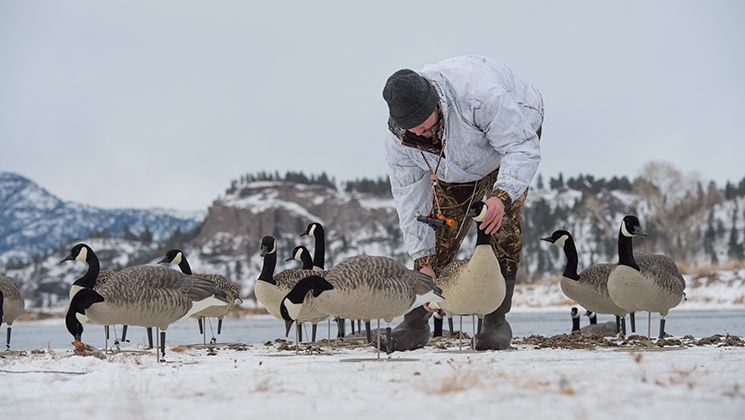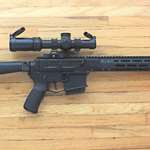
When you think about it, given that more than 90 percent of goose hunters set up in harvested crop fields, it’s little wonder late-season Canadas get a bit wary approaching a spread. Over the prior months they’ve seen pretty much every decoy configuration one can think up, learned to look for any suspicious rectangular lumps and shadows that say “layout blind there … there … and there,” and heard enough ill-timed and overly aggressive calling (probably from me) to know when someone’s crying fowl. If your success seems to suffer as the season goes on, look to your fellow hunters for why; you’re probably all out there doing the very same things.
One of the keys to fooling educated birds is to be different than the competition, to stand out with a spread the geese haven’t seen 200 times before. And there’s perhaps no better way than hunting over water. Not just any water, mind you, since the last thing you want to do is bust a roost and potentially spook your main source of birds into the next county. What you’re looking for is water geese use for daytime roosting, or loafing areas, places they’ll frequent after feeding.
Where to Look
It doesn’t take a lot of water to attract birds. One of my friend Brian Hauptman’s favorite places to hunt both geese and ducks in western Nebraska is in a cow pasture where a warm-water spring seep covers an area not much bigger than the average living room. The colder it gets and the more water sources freeze up in the area, the more productive the seep becomes. Other potential hotspots include spring creeks and spring-fed ponds, which can stay open even when the thermometer registers 20 below, hydroelectric plants, and perhaps the biggest source of cold-weather open water, rivers.
Even in extreme cold, rivers with enough flow, or with springs and riffles, provide plenty of open-water resting spots for waterfowl. And in tail waters below dams, rivers stay open for miles downstream. Islands can also provide birds with shallow-water loafing areas, particularly at the upstream and downstream ends, and any exposed gravel bar might be an excellent daytime roost site.
Don’t overlook ice shelves along shallow or slow-moving water, either. Torrington, Wyoming-based outfitter Jason Randolph of WyoBraska Waterfowl (wyobraskawaterfowl.com) hunts on and around the phenomenal North Platte River, and ice edges are some of his favorite spots to place decoys. I’ve seen his river setup in action, and using floaters, full-bodies standing in shallow water and plenty of decoys resting on the ice along the shore, it’s a pretty darned convincing charade. When Randolph hunts other spots that ice up in extreme cold, he’ll use an ice eater to entice geese and ducks.
“Geese love sitting on ice, so much so that you can even put decoys on a frozen pond and have them come in. Still, access to water is a big plus, and for guys who can afford it ($600-$800), ice eaters are awesome. I’ve opened up 20-inch-thick ice and created a whole new world of opportunities. The key is to not make the hole so big that birds can land outside gun range; you want enough room for a decent landing zone in the floating decoys and not much more.” Randolph will then stack his Bigfoot decoys on the ice all around the hole, except on the downwind side where the geese are approaching.
When to Hunt
Here’s another bonus to hunting loafing areas for all you sleep-deprived waterfowlers: Since you’re setting up for geese returning from feeding, there’s no need to get out at first light. And the colder it is, the later geese will leave their roost to feed.
If you’ve ever hunted rivers and tried to call in geese on their way to fields, you know the futility of trying to get them to go from water to water. Geese leaving a roost to feed aren’t going to change their flight plan no matter how big your spread or good your calling. But after they feed those same birds are all potential targets, as they need water to process their food and to clean feathers. On really cold days, sitting in water also helps them conserve more warmth than being fully exposed to colder air.
Typically you’ll see action between 10 a.m. to noon, although on extremely cold days geese might not leave the fields till early afternoon. Make sure you’ve allowed plenty of time to set up before the back flight begins. Too many times I’ve watched geese return to water while lugging my decoys to my blind.

Decoy Strategies
Joe Robison, Wildlife Biologist Supervisor for the Michigan DNR and Avian-X pro-staffer, frequently hunts loafing areas in the late season and tailors his spread not only to the number of honkers using the roost, but also to the temperature. “If 500-plus geese have been using a day roost,” says Robison, “a few dozen decoys aren’t going to be much of a draw, so I might set out 100 to 150 decoys. Of those, anywhere from 40 to 60 will be floaters. I’ll place full-bodies along the edge of the ice, mostly flat on their bellies to look like resting geese, and if the water’s shallow enough I’ll set out a number of rester-style decoys on stakes. This setup really imitates a bunch of loafing geese.
“If you don’t have lots of decoys, it’s not a huge issue when you’re hunting smaller numbers of geese,” he continues. “As long as you’ve done your homework, setting up on the ‘X’ will ensure you’re hunting where the geese want to go. Regardless of how many decoys you put out, be sure to include a good number of floaters. Nine times out of 10, incoming flocks will land in water, so floaters add realism to any water setup.”
When temperatures drop below 20 degrees, Robison changes his spread to mimic what geese naturally do, which is all about conserving energy. “I’ll start bunching up the decoys more and incorporating more sleepers into the spread; the colder it is, the more I put out. I’ll also use even more floaters, since geese prefer the relatively warmer water to the bitterly cold air. In order to get the geese landing where I want them to, I’ll usually arrange the decoys in a U- or J-shaped configuration.”
Jason Randolph hunts every day of the season, and along the North Platte River temperatures often dip well below zero. Despite the extreme cold, he doesn’t alter his decoy spread much. “I’ll definitely bunch my duck decoys around warm springs, but I haven’t seen much difference in how geese react to my spread relative to temperature. Maybe my sleeper decoys aren’t any good, but I never felt they helped me out.
“I do have plenty of full-bodies on the ice,” says Randolph, “as well as resters, where I’ve taken off my Bigfoot legs and filled the hollow spot with cement so they don’t blow over. Resters are pretty natural looking anytime during the season. I also place lots of full-bodies in shallow water, along with some floaters, which all together really look natural.”
Randolph does caution hunters to adapt their equipment to cold-weather hunting, especially on rivers where currents can be an issue. “The colder it is, the faster ice will build up on the sides of your decoys and the more ice floes you’ll have to contend with. If you don’t want to be constantly chasing your decoys downstream, rig them with heavy-duty weights. For goose floaters I use a 16-ounce pyramid weight; for ducks Rig’Em Right’s 12-ounce weights are perfect.
“For the full-bodies I place in the current, I attach each decoy to a steel pipe welded to stakes that go into the river bottom. That way if an ice floe hits, it won’t dislodge them. Cold-weather river hunting requires a lot of forethought if you want to concentrate on birds rather than worrying about losing your spread.”
Randolph says there’s one tool cold-weather hunters should never be without: brooms. On snowy days, goose hunting can be spectacular as geese don’t like flying then and the snow obscures their vision. Trouble is, if your decoys are covered in snow, all they’ll look like is a bunch of white bumps. When snow starts collecting on the backs of decoys, everyone runs out and starts sweeping away the snow. The faster they get it done, the sooner they’re back in action.
Calling and Other Considerations
Both Randolph and Robison adhere to conventional late-season calling wisdom, which can pretty much be summed up by “less is more.” A good strategy is to mimic the geese, so on mornings when they’re quiet, plan on being quiet as well. If you’re hunting under a flight path but not on the “X,” you may need to attract attention to your decoys with more aggressive calling. Once a flock’s heading your way, however, scale it way down. Flagging when geese are hundreds of yards off might be a better way to draw attention, especially when they’re not talking a lot. Jason Randolph has observed that the colder it is, the less the geese talk, usually making only the odd murmur or moan.
Another late-season rule of thumb applies as much to hunting over water as in fields: If you want to finish decoying geese, you’ve got to make being hidden your No. 1 concern. You can have a killer spread, be on the “X,” have the perfect wind, but if you’re not well hidden the geese aren’t coming in.
Birds that seem hesitant to commit might tell you something’s not right with your setup; flaring flocks say only one thing—the geese see you. Be sure your camo matches your surroundings, which for late-season hunting usually means good snow camo and snow covers for your blinds. Joe Robison has great success with a white cover on his Avian-X A-Frame blind, and Jason Randolph’s permanent blinds collect snow on their flat lids and blend perfectly into the winter landscape.
One thing’s for sure: You can’t rely on the majority of camo clothing to hide you, because most patterns, even for waterfowling, are way too dark to make you look like anything but a dark blob, snow or not. Much better camouflage are ghillie suits and blankets and leaf-o-flage-style outfits. Even if their color’s not perfect, their texture will enable you to blend into any surroundings better than a smooth-fabric garment. And if you spray a coat of Kilz white primer here and there, you’ll blend into any snowy scene.
When my buddy Luke Andrews and I started hunting islands on the Missouri River, we figured the willows and waist-high grass would hide us well enough to allow us to sit on low stools or kneel on the ground. As long as the cover wasn’t trampled down, we did okay. Toward the end of the season, however, natural cover started showing real signs of wear from our walking around, our dogs lying down, and snow and wind. Before long cupped-up geese would suddenly break off at 60 to 70 yards. Just as bad, birds flying higher than 25 yards could plainly see us while circling our spread, as we were essentially exposed. Stacking brush and branches higher had limited effect, so we brought in layout blinds, placed a thin layer of grass and brush over and around them, and the problem was solved.
When you’re not hunting a flat stubble field and have tall grass, weeds and brush at your disposal, it’s amazing how easy it is to hide a layout blind. It’s also a thrill calling shots when a flock of late-season Canadas is hovering just a few yards over the water, completely focused on where they’re going to land. Sure, you can finish geese potentially anytime you’re field-hunting. But by early January, when geese have been pressured hard and are hyper-cautious anytime they go out to feed, loafing areas offer hunters a fresh look and new tricks to fool wary birds. If your field setups are starting to feel a little stale, daytime roosts may be the perfect remedy.




































